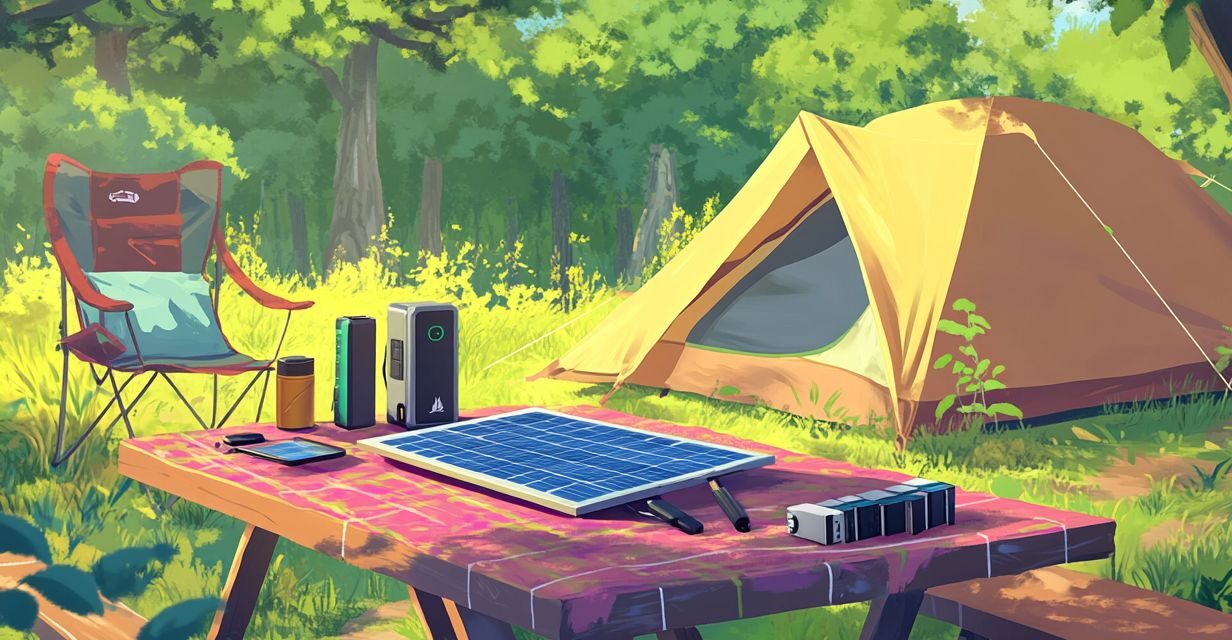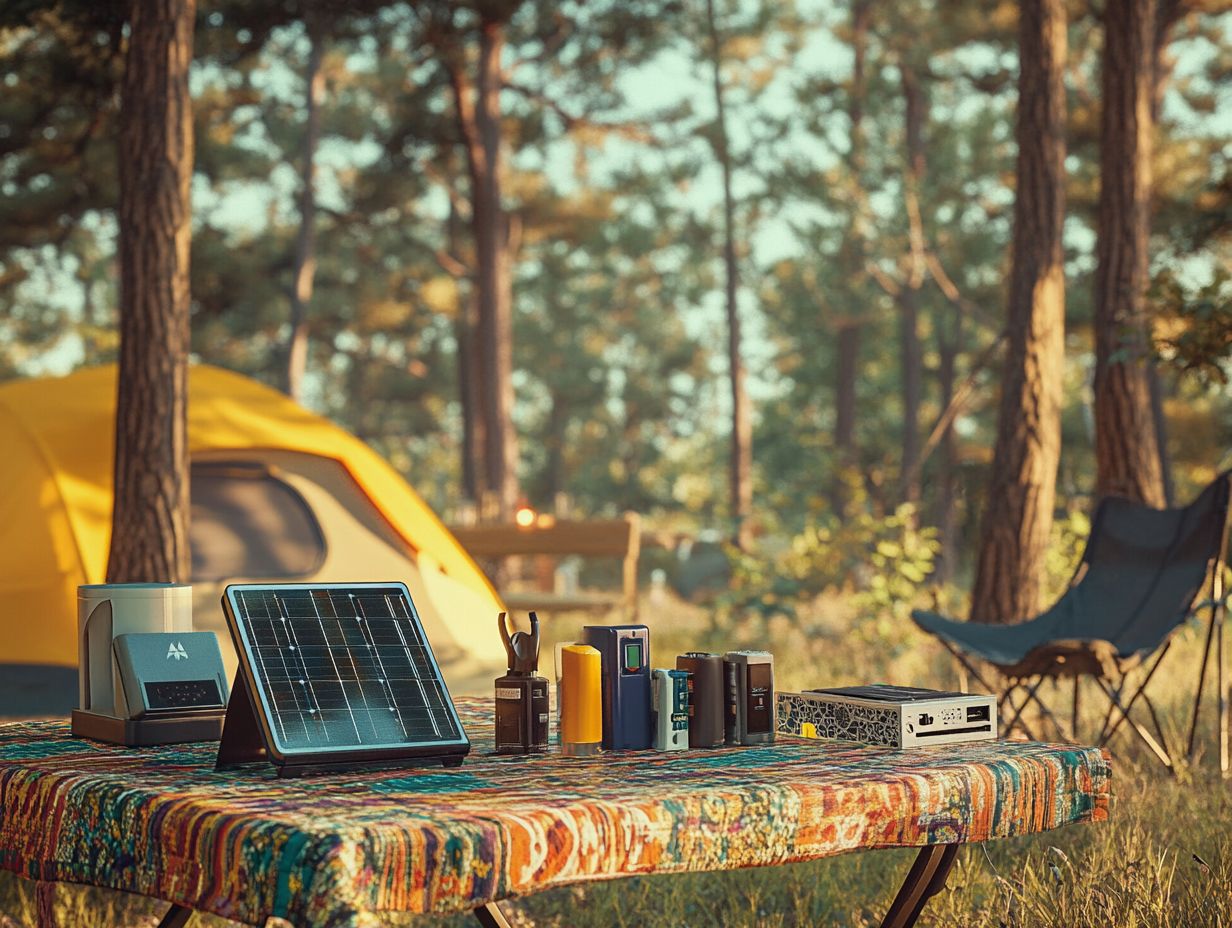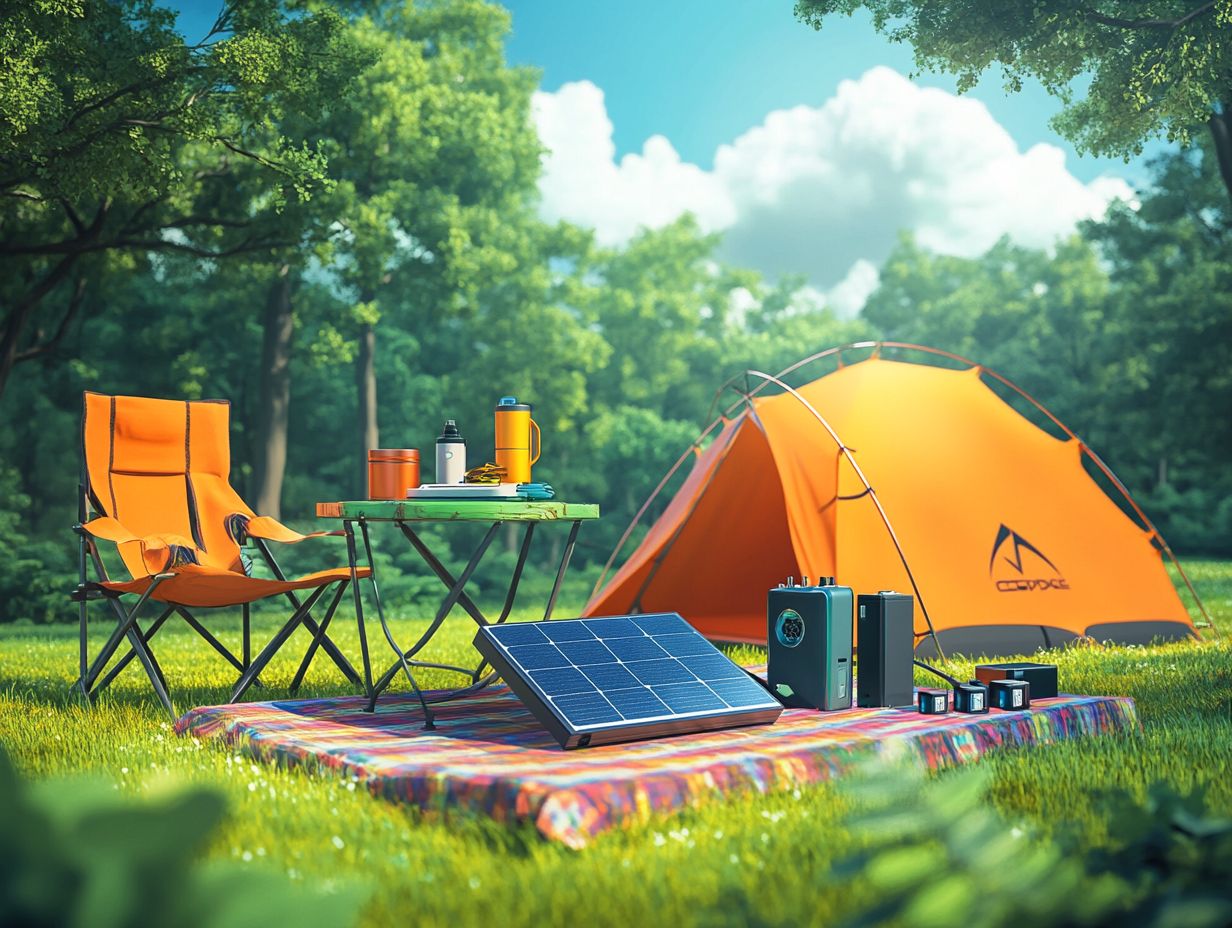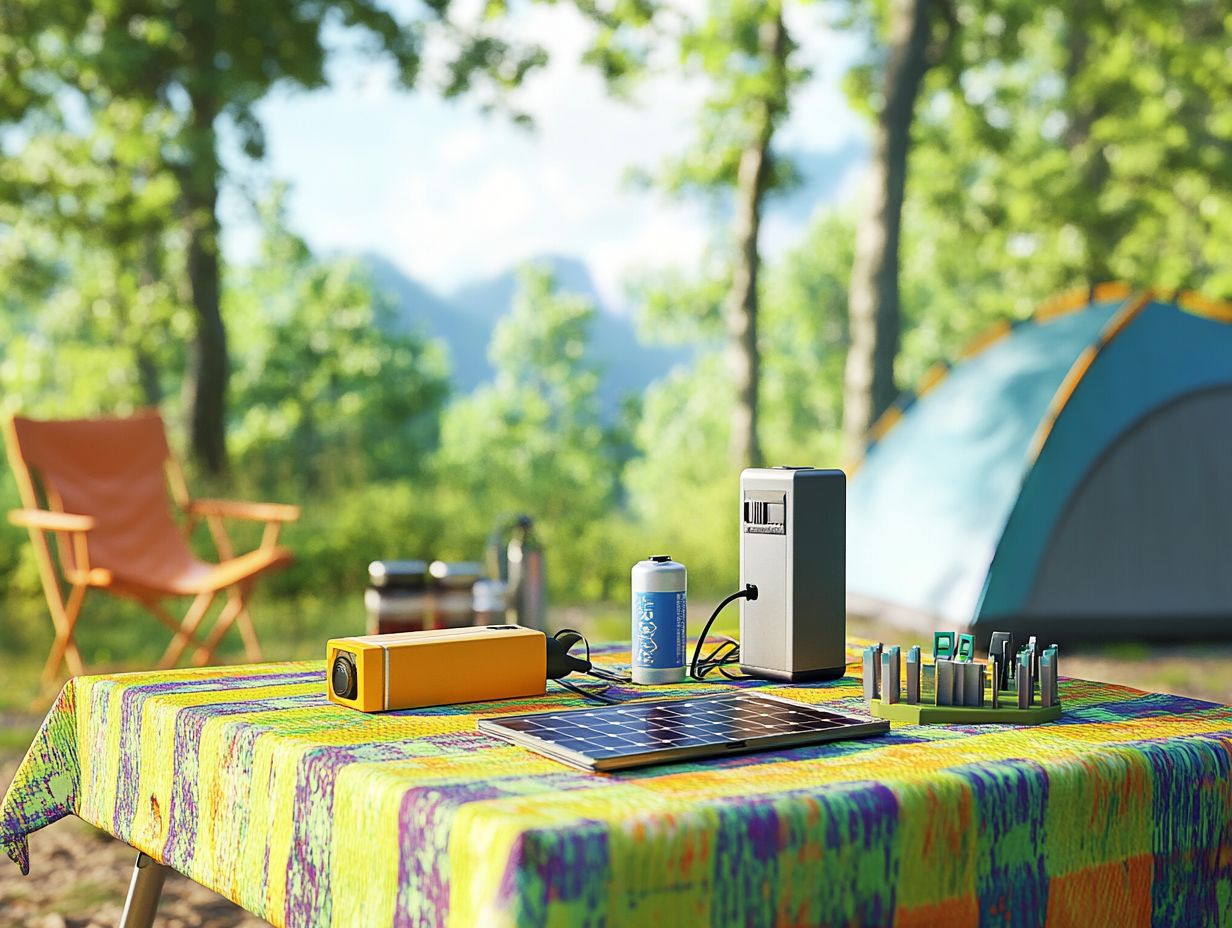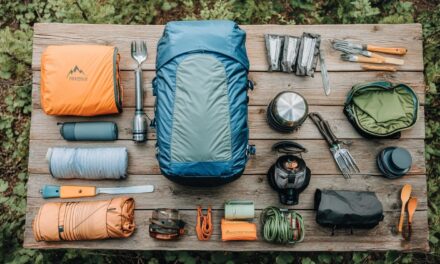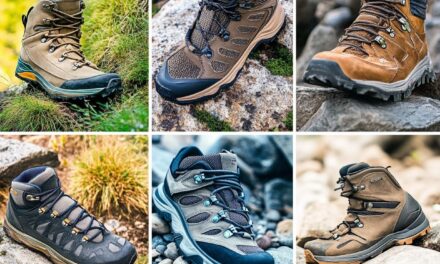Camping is all about embracing the great outdoors, but staying connected and powered up can enhance your adventure.
Whether you need to charge your devices, power your lights, or keep your gear running, choosing the right energy source is essential.
This guide explores the various options available—from batteries and power banks to solar chargers—offering insights into their types, such as travel solar and camping solar, and key factors to consider, along with product examples to help you make informed decisions.
Get ready to power up your campsite with effective sunlight!
Batteries for Camping
Regarding camping, choosing the right batteries is essential for ensuring that your power devices remain operational, allowing you to enjoy your outdoor adventures without interruption. The right batteries not only provide reliable power but also cater to the unique demands of camping scenarios, where access to traditional power sources may be limited. In this guide, we will delve into the types of batteries suitable for camping, factors to consider when making your choice, and examples of batteries that excel in various camping conditions.
Types of Batteries for Camping
There are several types of batteries specifically tailored for camping, including lithium-ion batteries, lead-acid batteries, and integrated battery systems that provide reliable energy for various power devices.
When planning a camping trip, the choice of battery can greatly influence your overall experience. Lithium-ion batteries are lightweight and offer high energy density, making them ideal for longer trips where space is a concern. Their longevity and fast recharging capabilities are significant advantages. However, their higher initial cost can be a downside.
- Lead-Acid Batteries: While generally heavier and bulkier, they are more affordable and widely available. They can be an excellent choice for group camping where space isn’t limited. They require regular maintenance and have a shorter lifespan, which can be a disadvantage for frequent campers.
- Integrated Battery Systems: These are ideal for tech-savvy campers who rely on multiple devices. They typically combine solar panels with battery storage, providing a sustainable energy source. On the flip side, they may be more complex to set up and can come at a premium cost.
Ultimately, the perfect battery for any camping adventure depends on individual needs, the duration of the trip, and the devices being powered. Choosing wisely will ensure a more enjoyable and stress-free outdoor experience.
Factors to Consider When Choosing Batteries for Camping
When selecting batteries for camping, it is crucial to consider factors such as charging speed, capacity, weight, and the reliability of power to ensure that your outdoor gear remains functional throughout your trip.
Delving deeper into these criteria, consider charging speed as a significant aspect; it determines how quickly your devices can be powered up, allowing for more spontaneous adventures without the worry of downtime.
Additionally,
- capacity plays a vital role in dictating how long your equipment can run without needing recharging, directly influencing your overall camping experience, especially during extended excursions.
- The weight of the batteries is critical to ease of transportation, ensuring that camping essentials don’t become cumbersome and impact your mobility.
- Finally, reliability is essential; choosing dependable batteries not only ensures consistent power supply but also enhances the safety and functionality of your camping gear.
Each of these factors collectively shapes the camping experience, enableing you to make informed decisions for memorable outdoor escapades.
Examples of Batteries for Camping
Some of the best batteries for camping include options like the Anker Powerhouse 90, Goal Zero Yeti 700, and EcoFlow 110, each designed to meet the specific power needs of outdoor enthusiasts.
Camping often requires reliable power sources to keep devices charged and maintain comfort in the great outdoors.
For instance, the Anker Powerhouse 90 boasts a compact design, featuring a 24,000mAh capacity, which is perfect for short weekend trips. It can charge essentials like smartphones and cameras multiple times.
- Goal Zero Yeti 700 offers an impressive 688Wh capacity and includes multiple output options, making it ideal for powering larger devices or even small appliances, perfect for longer stays, especially in backcountry adventures.
- The EcoFlow 110, on the other hand, shines with its lightweight and fast-charging capabilities, at just 11 pounds, making it suitable for backpacking adventures.
Each battery option caters to different camping styles and requirements, ensuring that enthusiasts can enjoy a seamless outdoor experience.
Power Banks for Camping
Power banks play a vital role in camping, providing a convenient and portable solution for charging devices on-the-go, especially when you’re in remote locations where electricity is scarce. With advancements in technology, many power banks now come with features such as fast charging and lightweight designs, making them ideal companions for outdoor adventures. In this section, we will explore different types of power banks suitable for camping, factors to consider when choosing them, and specific examples that can effectively meet your charging needs.
Types of Power Banks for Camping and Solar Chargers
There are several types of power banks ideal for camping purposes, including solar power banks, traditional lithium-ion power banks, and ultralight solar options that provide reliable power while being easy to transport.
When venturing into the great outdoors, campers often find themselves in need of reliable energy sources to keep their devices charged. Each type of power bank comes with its unique set of features that cater to different camping scenarios:
- Solar Power Banks: These are equipped with solar panels, allowing users to harness the sun’s energy during the day. While they provide sustainable power, their charging efficiency can be hindered by cloudy weather, making them less reliable in such conditions.
- Lithium-ion Power Banks: These are robust and generally offer faster charging times. Their significant drawback, however, is their weight, which can be an issue for those trekking over long distances.
- Ultralight Solar Power Banks: The perfect blend of portability and functionality, these compact options are ideal for minimalist campers but may have a lower capacity compared to heavier models.
Choosing the right power bank or solar charger depends on the camper’s specific needs, environment, and the devices that require charging.
Factors to Consider When Choosing Power Banks for Camping
When selecting a power bank for camping, important factors to consider include charging speed, capacity, weight, and user-friendly design, ensuring that the power bank meets your specific outdoor needs.
Each factor plays a significant role in enhancing the overall camping experience:
- Charging Speed: A fast-charging power bank means reduced waiting times, allowing campers to quickly recharge devices like smartphones or GPS units, which are essential for navigation and communication.
- Capacity: The capacity of a power bank, measured in milliamp hours (mAh), directly affects how many devices it can power and for how long. A higher capacity is ideal for longer trips where access to electricity is limited.
- Weight: For camping enthusiasts, every ounce counts. A lightweight power bank is easier to carry while still being capable of delivering sufficient energy to ensure all gadgets remain functional.
- User-Friendly Design: A well-designed power bank with clear ports and indicator lights allows for a hassle-free user experience, making it simpler for campers to check charges and connect devices, especially in low-light conditions.
By weighing these factors carefully, including the use of solar chargers, outdoor adventurers can find the perfect power bank tailored to their needs.
Examples of Power Banks and Solar Chargers for Camping
Notable examples of power banks for camping include the Anker SOLIX F2000, Scosche PowerUp 32K, and Jackery SolarSaga 100, each offering unique features that can cater to the needs of campers.
Regarding outdoor adventures, selecting the right power bank is essential for staying connected and powered up. These devices not only serve as reliable energy sources but also enhance the camping experience significantly. The Anker SOLIX F2000 is a robust option, boasting a high capacity of 2000Wh, perfect for charging multiple devices simultaneously with its fast-charging capabilities. Meanwhile, the Scosche PowerUp 32K stands out for its impressive portability, enabling campers to easily transport it while still providing sufficient juice for smartphones and tablets. The Jackery SolarSaga 100 is tailored for sustainability, featuring solar panels that allow users to harness solar power during their camping trips.
- Advantages: High power output, compact design, and the use of foldable solar options for portability.
- Ideal Use Cases: Weekend camping, long hikes, off-grid adventures
Each of these power banks ensures you remain charged and efficient, enabling unforgettable outdoor memories.
Solar Chargers for Camping
Solar chargers are a game-changer for camping, allowing outdoor enthusiasts to harness effective sunlight to charge their devices no matter where they are. These camping solar solutions come in various forms, including portable solar and foldable solar options that are easy to carry. In this section, we will discuss the types of solar chargers available for camping, considerations to keep in mind when choosing one, and specific examples that demonstrate the benefits of solar power in outdoor settings, including the best solar options for diverse needs.
Types of Solar Chargers for Camping
The types of solar chargers suitable for camping include lightweight panels, high-wattage solar chargers, and travel solar options designed to meet diverse energy needs during outdoor adventures, such as the Jackery SolarSaga 100 and the EcoFlow 110.
Each of these solar chargers offers unique advantages, making them particularly useful for outdoor enthusiasts who rely on portable energy sources. For instance, lightweight panels are perfect for hikers who prioritize minimal gear and need something easy to carry without sacrificing power. On the other hand, high-wattage solar chargers are ideal for campers who require more energy for larger devices like laptops or cooking equipment.
- Lightweight Solar Panels: Optimal for hiking and minimalists.
- High-Wattage Chargers: Great for powering multiple devices.
- Travel Solar Options: Versatile and designed for diverse uses.
These variations allow campers to choose based on their specific electricity needs, ensuring they stay powered up, whether they’re on a weekend trip or an extended wilderness retreat.
Factors to Consider When Choosing Solar Chargers for Camping
When selecting solar chargers for camping, consider factors like effective sunlight exposure, charging speed, and user-friendly design to ensure your devices are always powered. Understanding these key elements, such as energy conversion efficiency, will significantly influence your overall camping experience, making it crucial to choose wisely regardless of the outdoor conditions.
Regarding effective sunlight exposure, think about your camping location and the time of year; some areas may be prone to heavy tree cover or cloud cover that can limit solar absorption.
- Charging Speed: A quicker charging mechanism is essential, especially when you’re out in nature and relying on your devices for navigation or communication.
- User-Friendly Design: Opt for models that are lightweight and easy to set up, eliminating fuss during those precious camping moments.
Assess the durability of the solar charger since camping environments can be rugged. Investing in a reliable solar charger that adheres to these necessities will ultimately ensure that your gadgets remain functional and ready to use at all times.
Examples of Solar Chargers for Camping
Examples of effective solar chargers for camping include the Renogy 100W Foldable, BigBlue SolarPowa 28, and X-Dragon 20W, known for their reliability and efficiency in outdoor settings, along with the Anker SOLIX F2000 for even more options. These solar chargers are designed to meet the demanding needs of outdoor enthusiasts, ensuring that devices stay powered up even in remote locations.
When selecting the right solar charger, it is essential to consider various factors, including portability, output capacity, and the types of devices you plan to charge, especially those with multiple charging ports.
- Renogy 100W Foldable: This powerful option features dual USB outputs and an advanced monocrystalline panel that maximizes sunlight absorption, providing up to 100W of power. Its foldable design ensures easy transport, making it perfect for weekend getaways or longer camping trips.
- BigBlue SolarPowa 28: Renowned for its compact design, this 28W charger incorporates four solar panels and features smart IC technology to optimize charging efficiency. It’s ideal for charging small devices like phones and tablets, perfect for campers who want to stay connected.
- X-Dragon 20W: A versatile option, the X-Dragon offers dual USB ports and is known for its durability. Its lightweight construction and built-in LED indicator allow campers to monitor charging progress effortlessly, making it a reliable choice for outdoor adventures.
Each of these options excels in providing energy independence while enjoying the beauty of nature, ensuring that campers can charge their essential devices with confidence, whether using portable solar or larger power stations.
Comparing Batteries, Power Banks, and Solar Chargers for Camping
Comparing batteries, power banks, and solar chargers for camping reveals unique advantages and drawbacks associated with each power source, helping campers make informed decisions based on their specific needs, including options like the Anker Powerhouse 90 and the EcoFlow 110.
Pros and Cons of Each Power Source
Each power source—batteries, power banks, and solar chargers—has its pros and cons that can significantly impact your camping experience and the reliability of power during your trip.
When planning a camping adventure, it’s essential to assess how each option suits your needs.
- Batteries offer immediate energy for devices like flashlights and radios, making them incredibly handy. They are often single-use, leading to frequent replacements.
- Power banks provide a portable method to recharge devices, with many models capable of multiple charges depending on their capacity. Yet, they can take a long time to recharge themselves, especially if you’re reliant on a power source.
- In contrast, solar chargers, such as the Jackery SolarSaga 100 and the Bluetti AC60, harness natural sunlight, presenting a sustainable option; but their efficiency can drastically diminish on cloudy days or during winter months when sunlight is scarce.
Ultimately, understanding the unique characteristics of each power source will help campers make informed decisions, ensuring uninterrupted enjoyment of the great outdoors.
Tips for Maximizing Power Sources on a Camping Trip
Maximizing power sources on a camping trip involves strategic planning and careful consideration of your energy needs, including the use of solar generators and portable solar devices, to ensure that all your outdoor gear remains operational throughout your adventure.
By adopting a proactive approach to using batteries, power banks, and solar chargers, campers can not only enhance their overall experience but also ensure they are well-prepared for various scenarios, including charging multiple devices with the best solar options available. Here are some practical tips:
- Assess Your Power Needs: Before heading out, take inventory of all electronic devices you plan to use and estimate their energy consumption.
- Choose Efficient Gear: Opt for energy-efficient devices that require less power, helping you conserve your supplies.
- Utilize Solar Chargers: If camping in a sunny area, solar chargers can be a game-changer, such as the FlexSolar 40W, allowing campers to harness the sun’s energy to recharge batteries and power banks.
By implementing these energy management strategies, outdoor enthusiasts can enjoy the great outdoors without the worry of running low on power.
Conclusion
Finding the right combination of batteries, power banks, and solar chargers, including options like the Goal Zero Yeti 700, is essential for a successful camping experience, ensuring that all your devices remain charged and functional regardless of the location or conditions.
Understanding how these power sources work together, including the use of portable solar options, can greatly enhance outdoor adventures. Each option plays a crucial role in addressing specific needs like recharging phones, running small appliances, or providing light during nocturnal hours. As campers venture into remote areas, having a reliable power solution becomes paramount. Furthermore, the synergy of batteries, power banks, and solar chargers not only contributes to convenience but also to safety, especially in emergencies when communication devices must stay operational, such as in areas like Colorado.
- Consider the type of devices needed during your trip.
- Evaluate the length of your camping outing.
- Assess the environmental conditions—like sunlight availability—for optimal solar charging.
By paying attention to these factors, campers can ensure a seamless experience, free from the worry of depleted power sources.
Frequently Asked Questions
1. What are the benefits of using batteries, power banks, and solar chargers for camping?
These power sources offer convenience and versatility for your camping trip. Batteries provide a portable and reliable source of energy, power banks allow for easy recharging of devices, and solar chargers utilize renewable energy for an eco-friendly option.
2. What types of batteries are best for camping?
The best batteries for camping are rechargeable and have a high energy density, such as lithium-ion or nickel-metal hydride batteries. They are lightweight, durable, and can be recharged multiple times, making them a cost-effective choice for outdoor adventures.
3. Can I charge my phone with a power bank while camping?
Yes, power banks are designed to charge electronic devices, including phones. Look for power banks with a high capacity and multiple charging ports for added convenience while camping.
4. How do solar chargers work?
Solar chargers use photovoltaic cells to convert sunlight into electricity, which is then stored in a battery. This stored energy can be used to charge electronic devices, making it a sustainable option for camping.
5. What are the best features to look for in a solar charger for camping?
Look for solar chargers with a high wattage and efficiency, multiple charging ports, and durability for outdoor use. Some also come with built-in battery packs for storing energy, making them a reliable backup for cloudy days.
6. Can I use batteries, power banks, and solar chargers for other outdoor activities besides camping?
Absolutely! These power sources are versatile and can be used for a variety of outdoor activities, such as hiking, backpacking, and boating. They are also great to have on hand for emergency situations.

